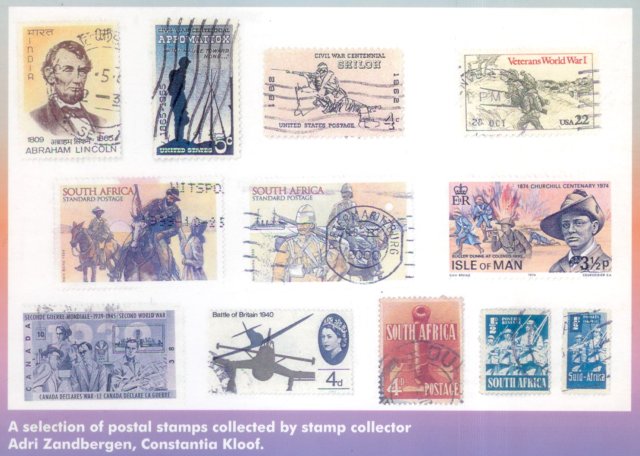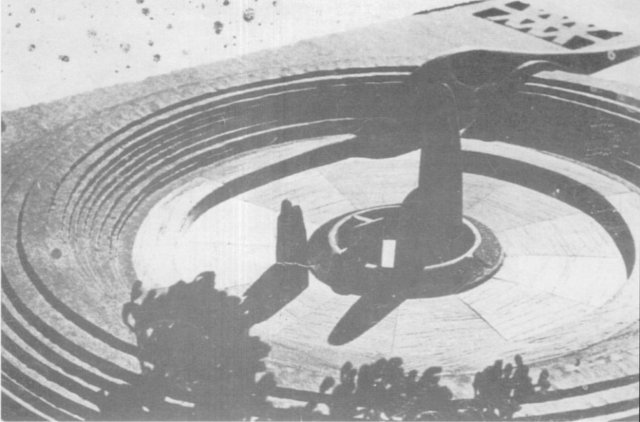

 The South African
The South African
Being a stamp-collector, I was recently sorting out my various albums. I realised I have a lot of stamps that could be classified under 'Military History'. I do not know if you could you use them in the Military History Journal as a 'space filler'. Maybe you could let me know?
As a member of the South African Military History Society, I always enjoy reading the journals. Also found your lecture in March about the 'Women's Territorial Service in East Africa' most interesting.
With kind regards,
Adri Zandbergen
Constantia Kloof
We have included a selection of these stamps on the back cover. - Ed.

Back cover photograph
'V' for a smile!
Compliments on your article on the SA ammunition column in the Desert Campaign.
Your cover photograph was interesting, and amusing, too. Have a good look at the two giving the 'V' sign. The man on the right is actually giving 'two's up'! It looks as if someone, maybe the censor, maybe the editor(!), tried to airbrush it out, but the location of the thumb rumbles the game. Just an aside.
Ben Brown (USA)
Not the editor, so it may have been the censor. Well spotted. Ed.
More Naval stories, please!
I have just received and read the latest journal. I enjoyed it.
I find it sad as a naval officer that there were no naval stories.
I volunteered and was accepted as a commissioned warrant rating in June 1941 and was demobilised as a lieutenant in the Royal Naval Volunteer Reserve in June 1946. I have been a member of the Naval Officers' Association since 1948, so have a long association with the Navy. On every ship on which I served, there was a South African. Many South Africans served with distinction in the Navy. The South African whalers played a vital part in the supplying of Tobruk. South African tankers and whalers were part of the escort force and did minesweeping off South African ports. South Africans were in the crew in the mini submarines which attacked the Tirpits. Jim Collier was in the Dieppe raid. HMSAS Gamtoos played a big role in clearing harbours. The stories are endless.
It would be lovely to have Naval stories in your journal.
Yours faithfully,
Robert M Ritchie
Watch out for Robert Ritchie's personal account of his own wartime experiences in a future issue of the Military History Journal. Readers are encouraged to follow his example and send in more stories about Naval military history. - Ed.
More on the naming of the War in South Africa, 1899-1902
Thank you for referring Dr Retiefs letter to me for comment. First of all, let me point outthat when I'm addressing a group of people in Afrikaans, I use the terms 'Eerste' and 'Tweede Vryheidsoorlog', since that is their historical sense of those two conflicts. In the same way, a British author speaks of the 'American Revolution' and his American counterpart speaks of the 'American War of Independence'; they are both entitled!
Dr Retief states that Prof Changuion has an unwritten rule that 'no country names a war after itself. But, at the time of the South African War, the term 'South Africa' referred to a geographical region and it only became a state with the Union in 1910. May I refer to the title of a book in my possession, The Royal Commission on the War in South Africa, printed in 1904.
The main point of my first letter was to ask the question - is it a mandatory rule for authors to use the terms '1st Anglo-Boer War' and '2nd Anglo-Boer War' and, if so, who made it mandatory?
Thank you once again for your valued advice.
David Panagos
The answer is that it is not mandatory, but was previously part of the house-style of the journal. There is a simple solution to this. As long as the name submitted by the author does not lead to further confusion, it will be retained as is. - Ed.
A reader asks ...
What is the fate of the Irish Brigade Memorial at the Brixton Tower?
I am trying to find out if the memorial to the Irish Brigade that fought for the Boers is still at Auckland Park, near the Radio Tower. If so, what state is it in? I last saw it over ten years ago. At that time, it was in a terrible state, apparently being used by vagrants as a toilet. Please can you be of assistance?
Brian P Kennedy

Above: The Irish Brigade Memorial, complete with central stone feature and surrounding rampart, as it appeared at the time of its opening in 1975. Today the site is empty, the central stones removed to Orania, and a grassy bank all that remains of the rampart.
The editor shares your concern about the current state of war memorials in the Greater Johannesburg Metropolitan Area. With regard to the Irish Brigade Memorial, also known as the Freedom Memorial, the editor was able to establish that it has been removed to a ridge in Orania. It is possible that the decision to relocate the Memorial there was influenced by the fact that it had been unveiled by Mrs Betsie Verwoerd(1 November 1975), later a well-known residentof Orania. The Memorial is also significant in that it is one of only two memorials in the world known to commemorate the role of Irish volunteers on the side of the Boers during the 1899-1902 war in South Africa. It is interesting from a historical-political point of view too, representing a perceived sense of common purpose between two small nations struggling for independence against a formidable world power, the British Empire. This is reflected in the structure of the memorial itself. The upright stones at the centre are said to be symbolic of the striving for ultimate freedom, while the rampart around the memorial, an integral feature of the whole design, was reminiscent of a laager, a place of refuge protecting those within from an external and all-enveloping enemy. Ed.
Words of Appreciation
I just received your Journal and, needless to say, paged through it at once. I now relish to have a few hours enjoyable reading ahead, especially Hamish's excellent English.
Thank you and my best regards.
Jochen Mahncke
Cape Town
Corrigendum, Military History Journal, Vol 13 No 3, June 2005
As a new member this year, I have thoroughly enjoyed dipping into the issue recently received. My spies tell me that Roland Tucker (pp 89-91) is a very distant cousin and that he turns 84 next month!
As his account was so precise, I wondered whether you might have incorrectly reflected the following: 'I flew one of three Baltimores up to the Adriatic Sea between Greece and Turkey'. The geography would be correct if 'and' were inserted after 'Sea'". The issue is whether he was shot down in the Aegean or Adriatic?
Very best wishes
Don Porter
Editor's mistake. The words 'between Greece and Turkey' were in parenthesis and should perhaps have been left as such. Welcome to the readership. - Ed.
KEN GILLINGS of KwaZulu·Natal was recently awarded LIFE MEMBERSHIP in recognition of his valuable contribution to the South African Military History Society over many years:
His letter to the Chairman:
It is simply impossible for me to find the right words to thank the Society enough for the singular honour that the Committee has bestowed upon me. Your presentation of that magnificent certificate which now adorns my study wall came as a huge surprise and was sincerely appreciated. Please convey my gratitude to the Committee and the Society for this wonderful gesture. My membership of the Society is undoubtedly a highlight of my life and I look forward to serving it for many years to come.
Kind regards
Yours UBIQUE,
Ken Gillings
Return to Journal Index OR Society's Home page
South African Military History Society / scribe@samilitaryhistory.org